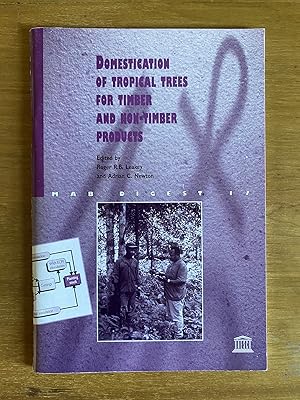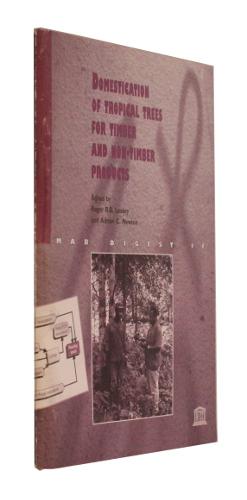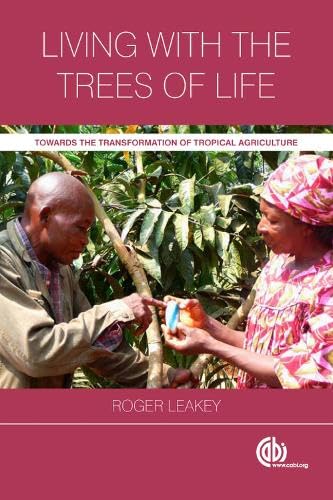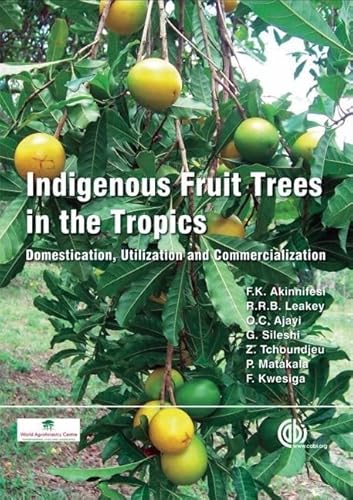leakey roger r b (23 résultats)
Filtres de recherche
Type d'article
- Tous les types de produits
- Livres (23)
- Magazines & Périodiques (Aucun autre résultat ne correspond à ces critères)
- Bandes dessinées (Aucun autre résultat ne correspond à ces critères)
- Partitions de musique (Aucun autre résultat ne correspond à ces critères)
- Art, Affiches et Gravures (Aucun autre résultat ne correspond à ces critères)
- Photographies (Aucun autre résultat ne correspond à ces critères)
- Cartes (Aucun autre résultat ne correspond à ces critères)
- Manuscrits & Papiers anciens (Aucun autre résultat ne correspond à ces critères)
Etat En savoir plus
- Neuf (15)
- Comme neuf, Très bon ou Bon (2)
- Assez bon ou satisfaisant (1)
- Moyen ou mauvais (Aucun autre résultat ne correspond à ces critères)
- Conformément à la description (5)
Particularités
- Ed. originale (1)
- Signé (Aucun autre résultat ne correspond à ces critères)
- Jaquette (Aucun autre résultat ne correspond à ces critères)
- Avec images (10)
- Sans impressions à la demande (23)
Langue (2)
Livraison gratuite
- Livraison gratuite à destination de France (Aucun autre résultat ne correspond à ces critères)
Pays
Evaluation du vendeur
-
Domestication of Tropical Trees for Timber and Non-Timber Products
Edité par UNESCO, Paris, 1994
Langue: anglais
Vendeur : Kilmaree Books, Strathcarron, Royaume-Uni
EUR 9,48
Autre deviseEUR 13,23 expédition depuis Royaume-Uni vers FranceQuantité disponible : 1 disponible(s)
Ajouter au panierSoft covers. Etat : Very Good. Mild edgewear to card covers. Pages clean. Binding firm. n.
-
EUR 34,50
Autre deviseEUR 4,90 expédition depuis Royaume-Uni vers FranceQuantité disponible : 15 disponible(s)
Ajouter au panierPAP. Etat : New. New Book. Shipped from UK. Established seller since 2000.
-
EUR 40,20
Autre deviseEUR 7,75 expédition depuis Etats-Unis vers FranceQuantité disponible : 1 disponible(s)
Ajouter au panierEtat : Used. pp. 224.
-
EUR 46,08
Autre deviseEUR 2,30 expédition depuis Royaume-Uni vers FranceQuantité disponible : 3 disponible(s)
Ajouter au panierPaperback. Etat : New. With our world torn by climate change, deforestation, land degradation, hunger, malnutrition, poverty, loss of wildlife habitat, zoonotic pandemics, illegal migration and social injustice, this book seeks to find a practical and pragmatic way forwards. Based on the author's extensive experience of tropical agriculture and forestry around the world, as well as his combination of practical and academic agricultural qualifications, the second edition of Living with the Trees of Life presents a unique and positive perspective on resolving these big global issues. It aims to identify principles, strategies, techniques, and skills to find a path through the maze of options for sustainable living in the tropics and subtropics. The book specifically draws heavily on a single case study which involved working to resolve the failure of tropical and subtropical agriculture to feed, sustain and support the needs of rural communities. To address the 'big picture' facing society, the work identified the traditionally important indigenous trees of tropical ecosystems - the trees of life - as a missing component of farming systems. These trees are keystones of the natural environment. Their products and critical ecological and social services have been overlooked by modern agriculture and should be recognized as the natural capital of the environment providing the very many day-to-day needs of local people. Many of today's big problems can be traced back to the breakdown of the natural, social and human capital of farming systems. Hence, a focus on restoring the natural capital also has important benefits for the livelihoods of the rural population, as well as for the productivity of the agroecosystem. However, the real potential is to go much further and to build new natural capital in the form of new socially-modified tree crops producing a very wide range of food, medicinal and other non-food products for new local business enterprises. This then restores the degraded social and human capital and starts to create new physical and financial capitals much needed for employment and economic development. There is, however, a missing 6th capital - the political and social will to change the way we manage our world by re-booting tropical agriculture and putting the needs of local people at the forefront of farming systems. Drawing on the technologies from across the spectrum of current conventional approaches to agricultural production, Living with the Trees of Life seeks to promote the adoption of a new way ahead - described as Land Maxing - that also increases the returns on past investments in agriculture. The target readership of this book is a wide and diverse array of people engaged in advocating and/or adopting ways to address the issues affecting our divided and dysfunctional world, before it is too late. Written in an accessible and engaging style, this book tells the story of how a new area of crop science has emerged across the tropics to create highly n.
-
EUR 39,34
Autre deviseEUR 10,18 expédition depuis Royaume-Uni vers FranceQuantité disponible : 1 disponible(s)
Ajouter au panierEtat : Used. pp. 224.
-
EUR 40,94
Autre deviseEUR 7,95 expédition depuis Allemagne vers FranceQuantité disponible : 1 disponible(s)
Ajouter au panierEtat : Used. pp. 224.
-
EUR 50,11
Autre deviseEUR 2,30 expédition depuis Royaume-Uni vers FranceQuantité disponible : 3 disponible(s)
Ajouter au panierPaperback. Etat : New. With our world torn by climate change, deforestation, land degradation, hunger, malnutrition, poverty, loss of wildlife habitat, zoonotic pandemics, illegal migration and social injustice, this book seeks to find a practical and pragmatic way forwards. Based on the author's extensive experience of tropical agriculture and forestry around the world, as well as his combination of practical and academic agricultural qualifications, the second edition of Living with the Trees of Life presents a unique and positive perspective on resolving these big global issues. It aims to identify principles, strategies, techniques, and skills to find a path through the maze of options for sustainable living in the tropics and subtropics. The book specifically draws heavily on a single case study which involved working to resolve the failure of tropical and subtropical agriculture to feed, sustain and support the needs of rural communities. To address the 'big picture' facing society, the work identified the traditionally important indigenous trees of tropical ecosystems - the trees of life - as a missing component of farming systems. These trees are keystones of the natural environment. Their products and critical ecological and social services have been overlooked by modern agriculture and should be recognized as the natural capital of the environment providing the very many day-to-day needs of local people. Many of today's big problems can be traced back to the breakdown of the natural, social and human capital of farming systems. Hence, a focus on restoring the natural capital also has important benefits for the livelihoods of the rural population, as well as for the productivity of the agroecosystem. However, the real potential is to go much further and to build new natural capital in the form of new socially-modified tree crops producing a very wide range of food, medicinal and other non-food products for new local business enterprises. This then restores the degraded social and human capital and starts to create new physical and financial capitals much needed for employment and economic development. There is, however, a missing 6th capital - the political and social will to change the way we manage our world by re-booting tropical agriculture and putting the needs of local people at the forefront of farming systems. Drawing on the technologies from across the spectrum of current conventional approaches to agricultural production, Living with the Trees of Life seeks to promote the adoption of a new way ahead - described as Land Maxing - that also increases the returns on past investments in agriculture. The target readership of this book is a wide and diverse array of people engaged in advocating and/or adopting ways to address the issues affecting our divided and dysfunctional world, before it is too late. Written in an accessible and engaging style, this book tells the story of how a new area of crop science has emerged across the tropics to create highly n.
-
EUR 50,96
Autre deviseEUR 3,45 expédition depuis Etats-Unis vers FranceQuantité disponible : 3 disponible(s)
Ajouter au panierPaperback. Etat : New. With our world torn by climate change, deforestation, land degradation, hunger, malnutrition, poverty, loss of wildlife habitat, zoonotic pandemics, illegal migration and social injustice, this book seeks to find a practical and pragmatic way forwards. Based on the author's extensive experience of tropical agriculture and forestry around the world, as well as his combination of practical and academic agricultural qualifications, the second edition of Living with the Trees of Life presents a unique and positive perspective on resolving these big global issues. It aims to identify principles, strategies, techniques, and skills to find a path through the maze of options for sustainable living in the tropics and subtropics. The book specifically draws heavily on a single case study which involved working to resolve the failure of tropical and subtropical agriculture to feed, sustain and support the needs of rural communities. To address the 'big picture' facing society, the work identified the traditionally important indigenous trees of tropical ecosystems - the trees of life - as a missing component of farming systems. These trees are keystones of the natural environment. Their products and critical ecological and social services have been overlooked by modern agriculture and should be recognized as the natural capital of the environment providing the very many day-to-day needs of local people. Many of today's big problems can be traced back to the breakdown of the natural, social and human capital of farming systems. Hence, a focus on restoring the natural capital also has important benefits for the livelihoods of the rural population, as well as for the productivity of the agroecosystem. However, the real potential is to go much further and to build new natural capital in the form of new socially-modified tree crops producing a very wide range of food, medicinal and other non-food products for new local business enterprises. This then restores the degraded social and human capital and starts to create new physical and financial capitals much needed for employment and economic development. There is, however, a missing 6th capital - the political and social will to change the way we manage our world by re-booting tropical agriculture and putting the needs of local people at the forefront of farming systems. Drawing on the technologies from across the spectrum of current conventional approaches to agricultural production, Living with the Trees of Life seeks to promote the adoption of a new way ahead - described as Land Maxing - that also increases the returns on past investments in agriculture. The target readership of this book is a wide and diverse array of people engaged in advocating and/or adopting ways to address the issues affecting our divided and dysfunctional world, before it is too late. Written in an accessible and engaging style, this book tells the story of how a new area of crop science has emerged across the tropics to create highly n.
-
EUR 52,39
Autre deviseEUR 3,45 expédition depuis Etats-Unis vers FranceQuantité disponible : 3 disponible(s)
Ajouter au panierPaperback. Etat : New. With our world torn by climate change, deforestation, land degradation, hunger, malnutrition, poverty, loss of wildlife habitat, zoonotic pandemics, illegal migration and social injustice, this book seeks to find a practical and pragmatic way forwards. Based on the author's extensive experience of tropical agriculture and forestry around the world, as well as his combination of practical and academic agricultural qualifications, the second edition of Living with the Trees of Life presents a unique and positive perspective on resolving these big global issues. It aims to identify principles, strategies, techniques, and skills to find a path through the maze of options for sustainable living in the tropics and subtropics. The book specifically draws heavily on a single case study which involved working to resolve the failure of tropical and subtropical agriculture to feed, sustain and support the needs of rural communities. To address the 'big picture' facing society, the work identified the traditionally important indigenous trees of tropical ecosystems - the trees of life - as a missing component of farming systems. These trees are keystones of the natural environment. Their products and critical ecological and social services have been overlooked by modern agriculture and should be recognized as the natural capital of the environment providing the very many day-to-day needs of local people. Many of today's big problems can be traced back to the breakdown of the natural, social and human capital of farming systems. Hence, a focus on restoring the natural capital also has important benefits for the livelihoods of the rural population, as well as for the productivity of the agroecosystem. However, the real potential is to go much further and to build new natural capital in the form of new socially-modified tree crops producing a very wide range of food, medicinal and other non-food products for new local business enterprises. This then restores the degraded social and human capital and starts to create new physical and financial capitals much needed for employment and economic development. There is, however, a missing 6th capital - the political and social will to change the way we manage our world by re-booting tropical agriculture and putting the needs of local people at the forefront of farming systems. Drawing on the technologies from across the spectrum of current conventional approaches to agricultural production, Living with the Trees of Life seeks to promote the adoption of a new way ahead - described as Land Maxing - that also increases the returns on past investments in agriculture. The target readership of this book is a wide and diverse array of people engaged in advocating and/or adopting ways to address the issues affecting our divided and dysfunctional world, before it is too late. Written in an accessible and engaging style, this book tells the story of how a new area of crop science has emerged across the tropics to create highly n.
-
EUR 28,60
Autre deviseEUR 5,95 expédition vers FranceQuantité disponible : 1 disponible(s)
Ajouter au panierDos agrafé. In-8 (16.5x24 cm), dos agrafé, couverture illustrée, 94 pages, ouvrage collectif en anglais, n°17 de 'Mab Digest' lancée par l'UNESCO en 1989, illustrations en noir et blanc dans le texte ; dos et coiffes frottés, intérieur frais, assez bon état. Livraison a domicile (La Poste) ou en Mondial Relay sur simple demande. Mab Digest.
-
EUR 77,75
Autre deviseEUR 7,75 expédition depuis Etats-Unis vers FranceQuantité disponible : 1 disponible(s)
Ajouter au panierEtat : New. pp. 224.
-
EUR 78,55
Autre deviseEUR 10,18 expédition depuis Royaume-Uni vers FranceQuantité disponible : 1 disponible(s)
Ajouter au panierEtat : New. pp. 224 36 Illus.
-
EUR 80,33
Autre deviseEUR 7,95 expédition depuis Allemagne vers FranceQuantité disponible : 1 disponible(s)
Ajouter au panierEtat : New. pp. 224.
-
INDIGENOUS FRUIT TREES IN THE TROPICS: DOMESTICATION, UTILIZATION, AND COMMERCIALIZATION
Edité par CAB Interational, Cambridge, MA, 2008
ISBN 10 : 1845931106 ISBN 13 : 9781845931100
Langue: anglais
Vendeur : Second Story Books, ABAA, Rockville, MD, Etats-Unis
Edition originale
EUR 79,86
Autre deviseEUR 39,63 expédition depuis Etats-Unis vers FranceQuantité disponible : 1 disponible(s)
Ajouter au panierHardcover. First Edition. Octavo, xx, 438 pages. In Very Good condition. Lime green spine with black lettering. Boards have mild shelving wear, a small tear along head joint corner of rear board, a dent along rear board join, and mild wear along spine head and tail. Textblock has mild staining along edges. Shelved ND-C. 1379812. FP New Rockville Stock.
-
Multifunctional Agriculture : Achieving Sustainable Development in Africa
Vendeur : GreatBookPrices, Columbia, MD, Etats-Unis
EUR 109,30
Autre deviseEUR 17,22 expédition depuis Etats-Unis vers FranceQuantité disponible : Plus de 20 disponibles
Ajouter au panierEtat : New.
-
Multifunctional Agriculture : Achieving Sustainable Development in Africa
Vendeur : GreatBookPricesUK, Woodford Green, Royaume-Uni
EUR 110,17
Autre deviseEUR 17,25 expédition depuis Royaume-Uni vers FranceQuantité disponible : Plus de 20 disponibles
Ajouter au panierEtat : New.
-
Multifunctional Agriculture : Achieving Sustainable Development in Africa
Vendeur : GreatBookPrices, Columbia, MD, Etats-Unis
EUR 125,34
Autre deviseEUR 17,22 expédition depuis Etats-Unis vers FranceQuantité disponible : Plus de 20 disponibles
Ajouter au panierEtat : As New. Unread book in perfect condition.
-
Multifunctional Agriculture : Achieving Sustainable Development in Africa
Vendeur : GreatBookPricesUK, Woodford Green, Royaume-Uni
EUR 126,14
Autre deviseEUR 17,25 expédition depuis Royaume-Uni vers FranceQuantité disponible : Plus de 20 disponibles
Ajouter au panierEtat : As New. Unread book in perfect condition.
-
Indigenous Fruit Trees in the Tropics
Vendeur : Kennys Bookshop and Art Galleries Ltd., Galway, GY, Irlande
EUR 166,50
Autre deviseEUR 3 expédition depuis Irlande vers FranceQuantité disponible : Plus de 20 disponibles
Ajouter au panierEtat : New. 2007. First. Hardcover. . . . . .
-
EUR 177,94
Autre deviseEUR 10,18 expédition depuis Royaume-Uni vers FranceQuantité disponible : 3 disponible(s)
Ajouter au panierEtat : New. pp. xx + 438 Illus.
-
Indigenous Fruit Trees in the Tropics Domestication, Utillization and Commercialization
Vendeur : Revaluation Books, Exeter, Royaume-Uni
EUR 177,84
Autre deviseEUR 11,50 expédition depuis Royaume-Uni vers FranceQuantité disponible : 2 disponible(s)
Ajouter au panierHardcover. Etat : Brand New. 464 pages. 9.75x7.00x1.25 inches. In Stock.
-
EUR 192,28
Autre deviseEUR 7,75 expédition depuis Etats-Unis vers FranceQuantité disponible : 3 disponible(s)
Ajouter au panierEtat : New. pp. xx + 438.
-
EUR 207,27
Autre deviseEUR 2,71 expédition depuis Etats-Unis vers FranceQuantité disponible : Plus de 20 disponibles
Ajouter au panierEtat : New. 2007. First. Hardcover. . . . . . Books ship from the US and Ireland.















